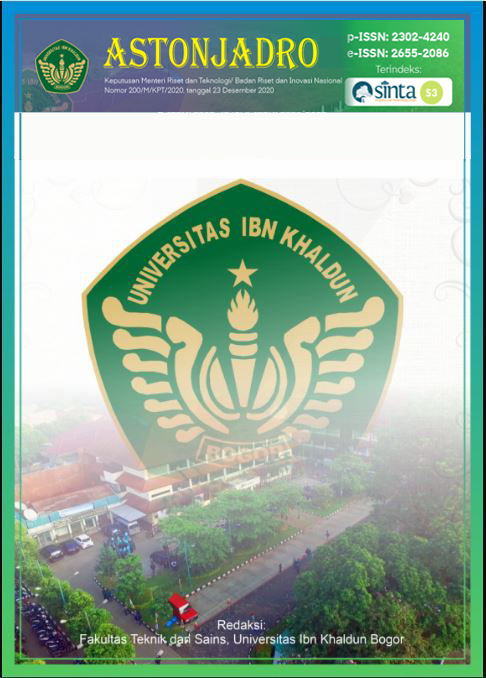Effect of Corrosion on Steel Strength (ST. 37)
DOI:
https://doi.org/10.32832/astonjadro.v13i3.16577Keywords:
steel St.37; corrosion; tensile strength.Abstract
Rust on steel is often a problem in construction work. Rust occurs when iron oxidizes. The cause is prolonged exposure to water, air, or an acidic environment. Iron will bind oxygen atoms in the air to form iron oxide/rust. Rust continues to increase, accelerating the process of damage to buildings. Rust cannot be avoided, but it can control its rate. St.37 carbon steel is the most widely used material for various types of building construction. Therefore, it is necessary to carry out experimental tests regarding the rate of corrosion and its effect on the strength of steel. In this research, using St.37 steel plates, the corrosion process was carried out by leaving the specimens in an open space, immersing the specimens in sea water, and immersing the specimens in fresh water for 15 days. The aim of this research is to analyze the corrosion rate and its effect on the strength of St.37 carbon steel material. Based on the research results, the average corrosion rate of test plates in open spaces was 0 MPy with an extraordinary resistance category; soaked in sea water 14.76 MPy with good category; and soaked in fresh water 39.37 MPy with the fair category. Meanwhile, based on the tensile test results, the average strength was 560.8 MPa for objects, 510.4 MPa, and 492.8 MPa, respectively. This corrosion rate affects the strength of the steel, the greater the corrosion rate, the tensile strength of the steel plate decreases.
References
Amri Abdulah, Solehudin, A., & Nugraha, H. (2019). Analisa Dampak Laju Korosi Terhadap Kekuatan Oven Wire Belt (Baja Karbon AISI 1065). Teknologika, 9(2). http://jurnal.stt-wastukancana.ac.id/index.php/teknologika/article/view/12/8
ASTM E8. (2010). ASTM E8/E8M standard test methods for tension testing of metallic materials 1. Annual Book of ASTM Standards 4, C, 1–27. https://doi.org/10.1520/E0008
Ginting, D. T. K. D. H. A. K. (2022). Ahli Korosi Dasar (M. Akhsani Taqwiym, Spd., M.Kom Nurussama, SE. (ed.); Cetakan Pe). UPT. Penerbit dan Percetakan Universitas Sriwijaya 2022 Kampus Unsri Palembang Jalan Srijaya Negara, Bukit Besa .r Palembang 30139. www.unsri.unsripress.ac.id
Gurum AP. Ayu SA, Dita Rahmayanti, dan N. E. (2015). Perhitungan Laju Korosi di dalam Larutan Air Laut dan Air Garam 3 % pada Paku dan Besi ASTM A36. Gravity, 1.
Hajar Isworo, S.Pd., M. T. (2018). Mekanika Kekuatan Material I. In Buku Ajar. PROGRAM STUDI TEKNIK MESIN FAKULTAS TEKNIK UNIVERSITAS LAMBUNG MANGKURAT.
Hartono, R., & Subigyar, D. (2020). Laju korosi pada baja karbon medium plat A36 direndam dalam media air laut dan air tawar. Dinamika Jurnal Teknik Mesin Unkhair, 5(1), 16–19.
Irawan, H., Ali, M. I., & Kanaka, W. (2023). Analisis Laju Korosi Baja Ss-Aisi 304 Media Air Laut , Air Payau , dan Air Kolam Pada Rangka Mesin Pakan Ikan Otomatis. Seminar Nasional Sains Dan Teknologi Terapan XI 2023 Institut Teknologi Adhi Tama Surabaya, 1–6.
Kevin J. Pattireuw, Fentje A. Rauf, R. L. (2013). Analisis Laju Korosi Pada Baja Karbon Dengan Menggunakan Air Laut Dan H2So4. Universitas Sam Ratulangi Manado, 10.
Matheus Souisa. (2011). ANALISIS MODULUS ELASTISITAS DAN ANGKA POISSON BAHAN DENGAN UJI TARIK (The Analysis of Modulus of Elasticity and Poisson Number using the Pull Test). Jurnal Barekeng, 5(2), 9–14.
Nasution, M. (2018). Karakteristik Baja Karbon Terkorosi oleh Air Laut. Buletin Utama Teknik, 14(1), 68–76.
Natasya, T., Khairafah, M. E., Br Sembiring, M. S., & Hutabarat, L. N. (2022). Corrosion Factors on Nail. Indonesian Journal of Chemical Science and Technology (IJCST), 5(1), 47. https://doi.org/10.24114/ijcst.v5i1.33159
Putri, A., & Amalia, Y. (2022). Pengaruh Korosi Terhadap Kegagalan Logam pada Jembatan : Literature Review. Jurnal Mekanik Terapan, 03(02), 65–69. https://doi.org/10.32722/jmt.v3i2.4597
Saputro, F. D., & Sutjahjo, D. H. (2017). Variasi Media Pengkorosi dan Waktu terhadap Laju Korosi pada Baja Rendah Karbon (Mild Steel) dengan Pemodelan Kondisi Sirip Kemudi Kapal. Jtm, 5(3), 59–66.
Subardi , Djoko Suprijanto, R. L. R. M. (2009). Effect of Post Heat Temperature To Hardness and. Traksi, 9(1), 7–12.
Utomo, B. (2009). Jenis korosi dan penanggulangannya. KAPAL, 6(2), 138–141.
Downloads
Published
How to Cite
Issue
Section
License
Copyright (c) 2024 ASTONJADRO

This work is licensed under a Creative Commons Attribution-ShareAlike 4.0 International License.
Paper submitted to ASTONJADRO is the sole property of the Astonjadro Journal. Unless the author withdraws the paper because he does not want to be published in this journal. The publication rights are in the journal Astonjadro.ASTONJADRO
LICENSE
This work is licensed under a Creative Commons Attribution-ShareAlike 4.0 International License.
Based on a work at http://ejournal.uika-bogor.ac.id/index.php/ASTONJADRO













